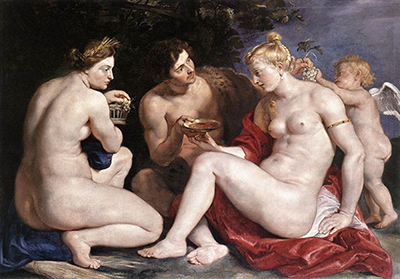This mythological painting from 1612-1613 features Venus, Cupid, Ceres and Dionysus within a large canvas that stretches to two metres in width. It can now be found at the Museumslandschaft Hessen Kassel in Germany.
Rubens was famous for capturing an honest depiction of the human body, with all of its curves and folds, rather than providing only an ideal. It was unusual to do so during his own period of work but this approach helped him to stand out. We find similar within the portraits here, though there remains the mythological nature here as well. You will find Venus particularly common within Rubens' career and he consulted literature many times in order to find inspiration for his paintings. The artwork here features a relaxed scene in which the various figures share food together in the outdoors, as if having a picnic whilst sat on elegant cloths. There is a suggestion of trees and shrubs behind, as well as a small window of sky showing through in order to set the scene.
We find here Ceres and Bacchus offering food and wine to Venus and Cupid, representing their respective symbols. This composition is inspired by Roman literature, where a similar set up is described by Terence. It tells of how Ceres and Bacchus were relied upon by their guests, though Rubens chose to avoid creating too much of a feast here and keeps the spread fairly modest in order to avoid the viewer feeling encouraged towards greed or glutony. Such considerations of society were important within art until only recently, as society became more relaxed and less judgemental. Art itself has also been allowed to work in different ways with less constraint from academics than used to be the case during the Baroque era.
The artwork is believed to be specifically in the Staatliche Museen, as part of the overall Museumslandschaft Hessen which covers many different venues under the same title. A visit to see this piece will also give you the opportunity to check out the Old Masters Picture Gallery in Wilhelmshöhe Palace which features a great number of other notable European artists from previous centuries, including the likes of Rubens, Frans Hals, Van Dyck, Dürer, Titian, Poussin and Murillo. There are around 800 paintings in total to enjoy from many of the biggest names in European art, making it an excellent day out and a highly prized collection that most would cherish the opportunity to see in person.




